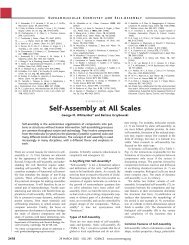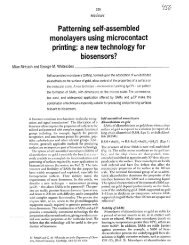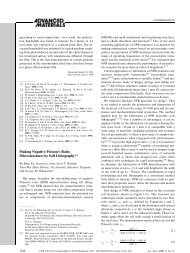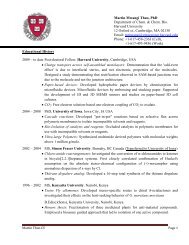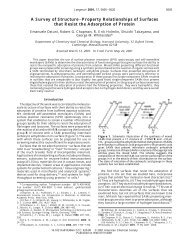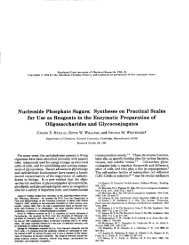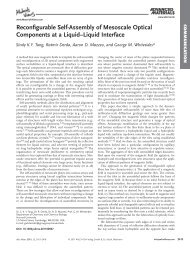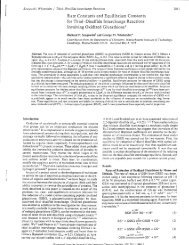Self-Assembled Monolayers of Thiolates on Metals as - Whitesides ...
Self-Assembled Monolayers of Thiolates on Metals as - Whitesides ...
Self-Assembled Monolayers of Thiolates on Metals as - Whitesides ...
Create successful ePaper yourself
Turn your PDF publications into a flip-book with our unique Google optimized e-Paper software.
1150 Chemical Reviews, 2005, Vol. 105, No. 4 Love et al.<br />
thiolates and subsequent desorpti<strong>on</strong> (see secti<strong>on</strong> 4.3).<br />
Molecular interacti<strong>on</strong>s between neighboring chains,<br />
such <strong>as</strong> networks <str<strong>on</strong>g>of</str<strong>on</strong>g> hydrogen b<strong>on</strong>ds, could provide<br />
<strong>on</strong>e means for improving the stability <str<strong>on</strong>g>of</str<strong>on</strong>g> the m<strong>on</strong>olayer.<br />
283,695<br />
9. Applicati<strong>on</strong>s <str<strong>on</strong>g>of</str<strong>on</strong>g> SAMs <strong>on</strong> Nanostructures<br />
Templated synthesis <str<strong>on</strong>g>of</str<strong>on</strong>g> nanostructures is an approach<br />
to forming nanometer-scale, metallic objects<br />
with n<strong>on</strong>equilibrium (and <str<strong>on</strong>g>of</str<strong>on</strong>g>ten n<strong>on</strong>spherical) morphologies.<br />
Although the shapes themselves may<br />
exhibit new and interesting physical properties (optical,<br />
electr<strong>on</strong>ic, or magnetic), much <str<strong>on</strong>g>of</str<strong>on</strong>g> the interest in<br />
these types <str<strong>on</strong>g>of</str<strong>on</strong>g> structures focuses <strong>on</strong> their potential<br />
applicati<strong>on</strong>s, such <strong>as</strong> sensors, selective filters, or<br />
probes for biology. These nanostructures are smaller<br />
than cells; this size makes them useful for probing<br />
subcellular features. For example, magnetic nanostructures<br />
can be used to create very high localized<br />
field gradients or apply torque at subcellular levels. 696<br />
Metallic nanostructures with uniformly functi<strong>on</strong>alized<br />
surfaces could be used to target cells and bind<br />
to specific receptors. Without functi<strong>on</strong>alizati<strong>on</strong> the<br />
native metal surfaces are pr<strong>on</strong>e to n<strong>on</strong>specific protein<br />
adsorpti<strong>on</strong> and degradati<strong>on</strong> (oxidati<strong>on</strong>, decompositi<strong>on</strong>).<br />
42 For structures made from gold and other<br />
metals <strong>on</strong> which SAMs can form (Table 1), alkanethiols<br />
are used to impart new properties and functi<strong>on</strong>s.<br />
This secti<strong>on</strong> discusses some examples <str<strong>on</strong>g>of</str<strong>on</strong>g> templated<br />
nanostructures and applicati<strong>on</strong>s <str<strong>on</strong>g>of</str<strong>on</strong>g> such structures<br />
that use SAMs to tailor the compositi<strong>on</strong> <str<strong>on</strong>g>of</str<strong>on</strong>g> their<br />
surfaces.<br />
9.1. Electrodeposited Metal Rods<br />
Electrodepositi<strong>on</strong> <str<strong>on</strong>g>of</str<strong>on</strong>g> metals within mesoporous<br />
polycarb<strong>on</strong>ate or alumina membranes-a technique<br />
pi<strong>on</strong>eered by Martin697-can generate segmented<br />
nanowires with secti<strong>on</strong>s composed <str<strong>on</strong>g>of</str<strong>on</strong>g> different metals<br />
with c<strong>on</strong>trolled lengths (Figure 24a and b). There are<br />
reviews <str<strong>on</strong>g>of</str<strong>on</strong>g> the many applicati<strong>on</strong>s <str<strong>on</strong>g>of</str<strong>on</strong>g> these rods<br />
including their use <strong>as</strong> circuit comp<strong>on</strong>ents, 698 their<br />
applicati<strong>on</strong>s in biology, 699 and their use <strong>as</strong> bar-coded<br />
tags. 700 Rods c<strong>on</strong>taining nickel segments are particularly<br />
useful because <str<strong>on</strong>g>of</str<strong>on</strong>g> their magnetic properties. 701,702<br />
Many applicati<strong>on</strong>s <str<strong>on</strong>g>of</str<strong>on</strong>g> these rods rely <strong>on</strong> the orthog<strong>on</strong>al<br />
functi<strong>on</strong>alizati<strong>on</strong> <str<strong>on</strong>g>of</str<strong>on</strong>g> different metallic secti<strong>on</strong>s<br />
with different SAMs (secti<strong>on</strong> 7.3.4). For example,<br />
gold-platinum rods can be patterned with<br />
thiols <strong>on</strong> the gold segments and isocyanides <strong>on</strong> the<br />
platinum segments. 124 Gold-nickel rods can also be<br />
orthog<strong>on</strong>ally functi<strong>on</strong>alized using thiols to decorate<br />
the gold segments and carboxylic acids, which have<br />
a preference for the native oxide <strong>on</strong> the nickel, 39 to<br />
decorate the nickel segments. 41,42,702 Poly-histidine<br />
and proteins with poly-His tags have also been shown<br />
to bind selectively to nickel segments <str<strong>on</strong>g>of</str<strong>on</strong>g> gold-nickel<br />
rods. 701<br />
In biological applicati<strong>on</strong>s orthog<strong>on</strong>ally functi<strong>on</strong>alized<br />
rods make it possible to localize different proteins<br />
<strong>on</strong> individual segments. One applicati<strong>on</strong> <str<strong>on</strong>g>of</str<strong>on</strong>g> rods<br />
functi<strong>on</strong>alized in this way is the delivery <str<strong>on</strong>g>of</str<strong>on</strong>g> DNA<br />
pl<strong>as</strong>mids to a cell. Transferrin (a cell-targeting<br />
protein used for receptor-mediated gene delivery via<br />
endocytosis) 703 w<strong>as</strong> linked to the gold segments via<br />
Figure 24. Optical (a) and FE-SEM (b) images <str<strong>on</strong>g>of</str<strong>on</strong>g> a<br />
segmented nanorod with ∼550 nm gold segments and silver<br />
segments <str<strong>on</strong>g>of</str<strong>on</strong>g> 240, 170, 110, and 60 nm (from top to bottom).<br />
(Reprinted with permissi<strong>on</strong> from ref 704. Copyright 2001<br />
AAAS.) (c) Fluorescence micrograph <str<strong>on</strong>g>of</str<strong>on</strong>g> gold nanowires<br />
functi<strong>on</strong>alized with ssDNA <strong>on</strong>ly <strong>on</strong> the tips. After removal<br />
from the alumina membrane, the ssDNA w<strong>as</strong> hybridized<br />
with a rhodamine-modified complementary strand <str<strong>on</strong>g>of</str<strong>on</strong>g> ss-<br />
DNA. (d) Optical micrograph corresp<strong>on</strong>ding to the rods<br />
shown in c. (Reprinted with permissi<strong>on</strong> from ref 707.<br />
Copyright 2001 Wiley-VCH.)<br />
thiols and a DNA pl<strong>as</strong>mid w<strong>as</strong> localized <strong>on</strong> the nickel<br />
segments via electrostatic interacti<strong>on</strong>s with the amino<br />
group <str<strong>on</strong>g>of</str<strong>on</strong>g> 3-[(2-aminoethyl)dithio]propi<strong>on</strong>ic acid. 41 Similar<br />
chemistry h<strong>as</strong> been used to functi<strong>on</strong>alize the gold<br />
tips <str<strong>on</strong>g>of</str<strong>on</strong>g> nickel/gold rods with biotin; the rods were then<br />
magnetically manipulated <strong>on</strong>to silver surfaces functi<strong>on</strong>alized<br />
with avidin. 702 Another approach to localizing<br />
proteins to <strong>on</strong>e segment <str<strong>on</strong>g>of</str<strong>on</strong>g> a rod is to treat the<br />
gold segments with EG6-thiol and the nickel segments<br />
with palmitic acid. The EG-coated gold resists<br />
protein adsorpti<strong>on</strong>, while the hydrophobic nickel<br />
segments readily adsorb proteins. 42<br />
SAMs <strong>on</strong> metallic “barcodes”, rods patterned with<br />
secti<strong>on</strong>s <str<strong>on</strong>g>of</str<strong>on</strong>g> different metals, have been used to<br />
perform DNA hybridizati<strong>on</strong> <strong>as</strong>says and immuno<strong>as</strong>says.<br />
704,705 The rods are first functi<strong>on</strong>alized with<br />
mercaptoundecanoic acid and subsequently linked to<br />
the molecules or proteins <str<strong>on</strong>g>of</str<strong>on</strong>g> interest via peptide<br />
coupling reacti<strong>on</strong>s. The combinati<strong>on</strong> <str<strong>on</strong>g>of</str<strong>on</strong>g> the inherent<br />
reflectivities (Figure 24a) <str<strong>on</strong>g>of</str<strong>on</strong>g> the different metallic<br />
stripes-silver is more reflective than gold-and the<br />
fluorescence <str<strong>on</strong>g>of</str<strong>on</strong>g> a bound analyte is used <strong>as</strong> a readout<br />
for binding. Depending <strong>on</strong> the choice <str<strong>on</strong>g>of</str<strong>on</strong>g> metals<br />
and fluorescent labels, the barcode pattern can either<br />
be obscured by fluorescence or remain visible.<br />
The tips <str<strong>on</strong>g>of</str<strong>on</strong>g> nanorods (rather than their length) can<br />
be functi<strong>on</strong>alized with different SAMs by exposing<br />
the nanorods to a thiol soluti<strong>on</strong> before removing them<br />
from the membrane used for templating (Figure<br />
24c). 706,707 This technique h<strong>as</strong> been used to <strong>as</strong>semble<br />
rods in an end-to-end f<strong>as</strong>hi<strong>on</strong> using complementary<br />
single-stranded DNA. 707 It h<strong>as</strong> also been used to form<br />
molecular “juncti<strong>on</strong>s” in the nanorods by exposing the<br />
growing rod to a soluti<strong>on</strong> <str<strong>on</strong>g>of</str<strong>on</strong>g> an ω-functi<strong>on</strong>alized<br />
alkanethiol in the middle <str<strong>on</strong>g>of</str<strong>on</strong>g> the growth process and




